| Solar eclipse of October 2, 1959 | |
|---|---|
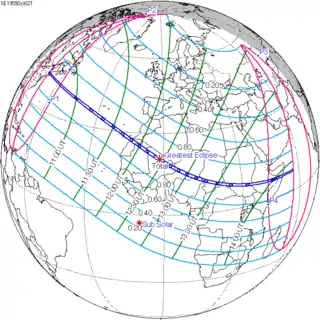 Map | |
| Type of eclipse | |
| Nature | Total |
| Gamma | 0.4207 |
| Magnitude | 1.0325 |
| Maximum eclipse | |
| Duration | 182 sec (3 m 2 s) |
| Coordinates | 20°24′N 1°24′W / 20.4°N 1.4°W |
| Max. width of band | 120 km (75 mi) |
| Times (UTC) | |
| Greatest eclipse | 12:27:00 |
| References | |
| Saros | 143 (20 of 72) |
| Catalog # (SE5000) | 9419 |
A total solar eclipse occurred on October 2, 1959. A solar eclipse occurs when the Moon passes between Earth and the Sun, thereby totally or partly obscuring the image of the Sun for a viewer on Earth. A total solar eclipse occurs when the Moon's apparent diameter is larger than the Sun's, blocking all direct sunlight, turning day into darkness. Totality occurs in a narrow path across Earth's surface, with the partial solar eclipse visible over a surrounding region thousands of kilometres wide. Totality was visible from northeastern Massachusetts and the southern tip of New Hampshire in the United States, Canary Islands, Morocco, Spanish Sahara (today's West Sahara) including the capital city Laayoune, French Mauritania (today's Mauritania), Mali Federation (part now belonging to Mali), French Niger (today's Niger), British Nigeria (today's Nigeria), British Cameroons and French Cameroons (now belonging to Cameroon), French Chad (today's Chad) including the capital city Fort-Lamy, French Central Africa (today's Central African Republic), Sudan (part of the path of totality is now in South Sudan), Ethiopia, and the Trust Territory of Somaliland (today's Somalia).
Observations
Totality began over Boston, Massachusetts at sunrise. Viewing the eclipse was rained out, but it was reported that the brightening of the sky after the eclipse was a startling and impressive sight.[1] A few photographers captured the eclipse from airplanes above the clouds, and a multiple exposure was made atop the R. C. A. building in New York City.[2] The next total eclipse over Boston, the solar eclipse of May 1, 2079, will also be a sunrise event.[3]
The event was also observed at the Canarian Island of Fuerteventura by a team of Dutch astronomers of the university of Utrecht and Amsterdam.[4][5]
Maurice Allais, a French polymath, reported the alleged anomalous behavior of pendulums or gravimeters, later named as Allais effect. He first reported the effect after observing the solar eclipse of June 30, 1954, and reported another observation of the effect during this solar eclipse using the paraconical pendulum he invented.[6]
Related eclipses
Solar eclipses of 1957–1960
This eclipse is a member of a semester series. An eclipse in a semester series of solar eclipses repeats approximately every 177 days and 4 hours (a semester) at alternating nodes of the Moon's orbit.[7]
| Solar eclipse series sets from 1957–1960 | ||||
|---|---|---|---|---|
| Descending node | Ascending node | |||
| Saros | Map | Saros | Map | |
| 118 |  1957 April 30 Annular (non-central) |
123 |  1957 October 23 Total (non-central) | |
| 128 |  1958 April 19 Annular |
133 | 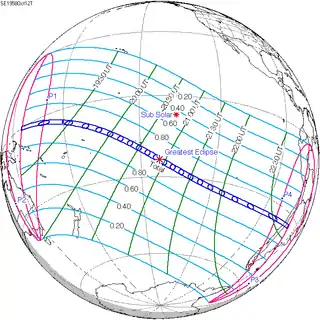 1958 October 12 Total | |
| 138 |  1959 April 8 Annular |
143 |  1959 October 2 Total | |
| 148 |  1960 March 27 Partial |
153 |  1960 September 20 Partial | |
Solar 143
It is a part of Saros cycle 143, repeating every 18 years, 11 days, containing 72 events. The series started with partial solar eclipse on March 7, 1617 and total event from June 24, 1797 through October 24, 1995. It has hybrid eclipses from November 3, 2013 through December 6, 2067, and annular eclipses from December 16, 2085 through September 16, 2536. The series ends at member 72 as a partial eclipse on April 23, 2873. The longest duration of totality was 3 minutes, 50 seconds on August 19, 1887. All eclipses in this series occurs at the Moon’s ascending node.
| Series members 17–28 occur between 1741 and 2100 | ||
|---|---|---|
| 8 | 9 | 10 |
 May 23, 1743 |
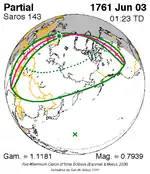 June 3, 1761 |
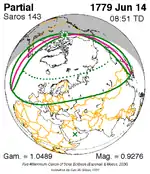 June 14, 1779 |
| 11 | 12 | 13 |
 June 24, 1797 |
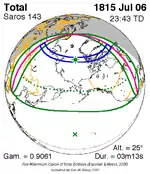 July 6, 1815 |
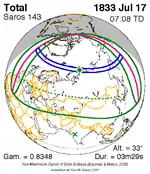 July 17, 1833 |
| 14 | 15 | 16 |
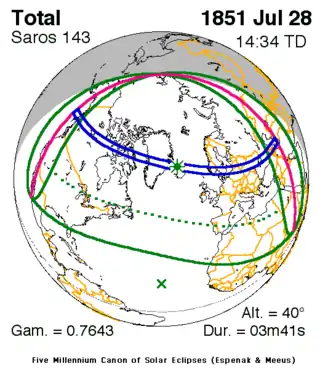 July 28, 1851 |
 August 7, 1869 |
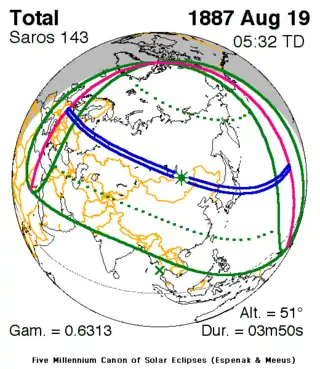 August 19, 1887 |
| 17 | 18 | 19 |
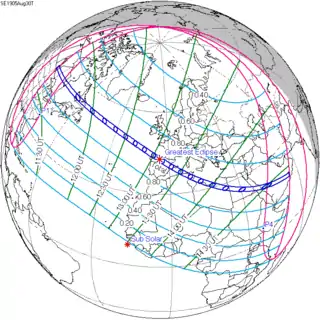 August 30, 1905 |
 September 10, 1923 |
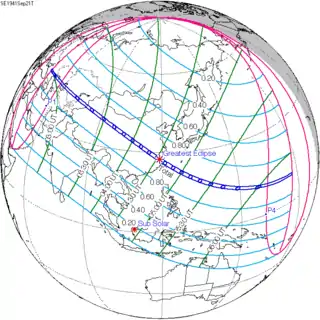 September 21, 1941 |
| 20 | 21 | 22 |
 October 2, 1959 |
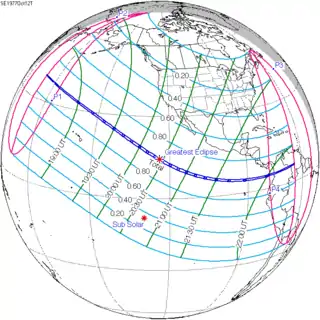 October 12, 1977 |
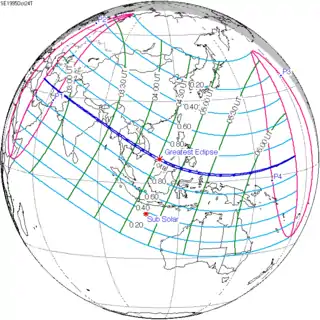 October 24, 1995 |
| 23 | 24 | 25 |
 November 3, 2013 |
 November 14, 2031 |
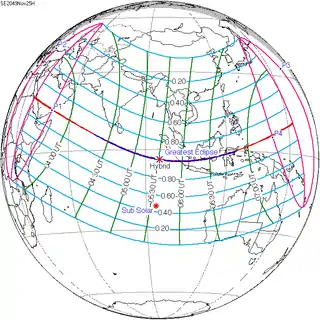 November 25, 2049 |
| 26 | 27 | 28 |
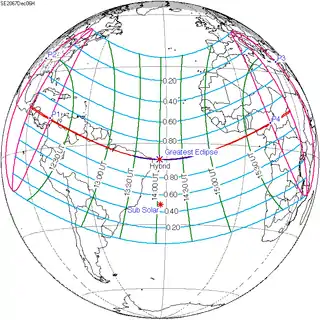 December 6, 2067 |
 December 16, 2085 | |
Inex series
This eclipse is a part of the long period inex cycle, repeating at alternating nodes, every 358 synodic months (≈ 10,571.95 days, or 29 years minus 20 days). Their appearance and longitude are irregular due to a lack of synchronization with the anomalistic month (period of perigee). However, groupings of 3 inex cycles (≈ 87 years minus 2 months) comes close (≈ 1,151.02 anomalistic months), so eclipses are similar in these groupings.
| Inex series members between 1901 and 2100: | ||
|---|---|---|
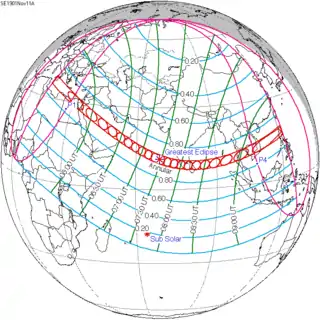 November 11, 1901 (Saros 141) |
 October 21, 1930 (Saros 142) |
 October 2, 1959 (Saros 143) |
 September 11, 1988 (Saros 144) |
 August 21, 2017 (Saros 145) |
 August 2, 2046 (Saros 146) |
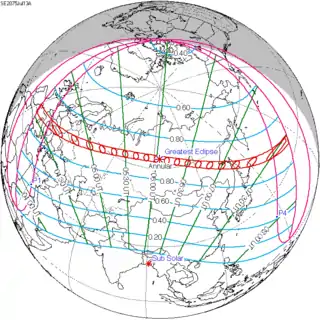 July 13, 2075 (Saros 147) |
||
Metonic series
The metonic series repeats eclipses every 19 years (6939.69 days), lasting about 5 cycles. Eclipses occur in nearly the same calendar date. In addition, the octon subseries repeats 1/5 of that or every 3.8 years (1387.94 days).
| 22 eclipse events between December 13, 1898 and July 20, 1982 | ||||
|---|---|---|---|---|
| December 13–14 | October 1–2 | July 20–21 | May 9 | February 24–25 |
| 111 | 113 | 115 | 117 | 119 |
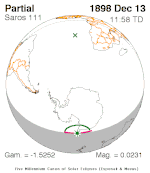 December 13, 1898 |
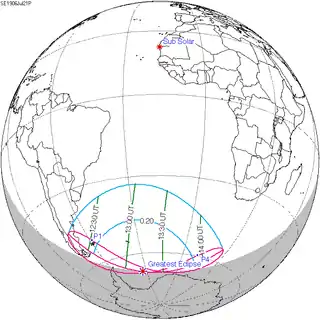 July 21, 1906 |
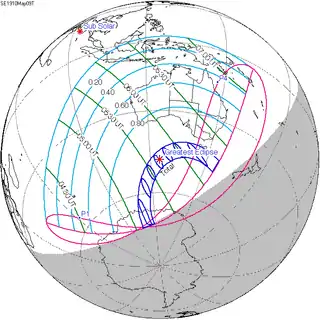 May 9, 1910 |
 February 25, 1914 | |
| 121 | 123 | 125 | 127 | 129 |
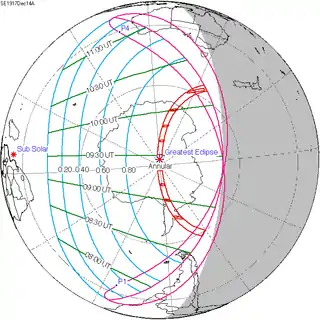 December 14, 1917 |
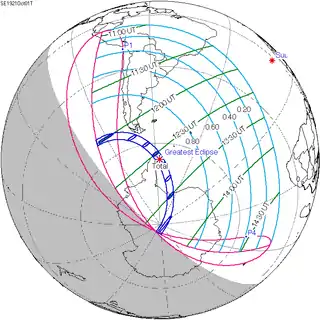 October 1, 1921 |
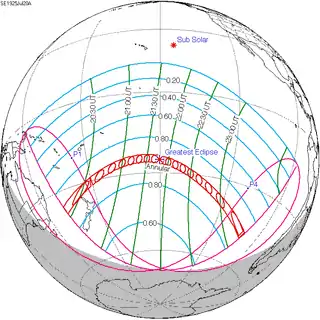 July 20, 1925 |
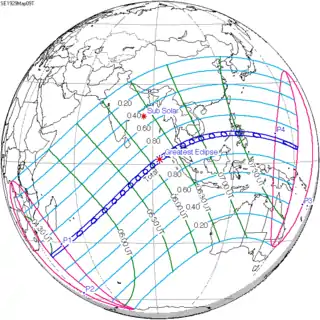 May 9, 1929 |
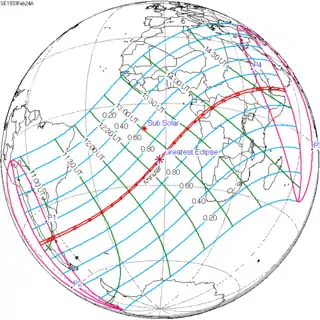 February 24, 1933 |
| 131 | 133 | 135 | 137 | 139 |
 December 13, 1936 |
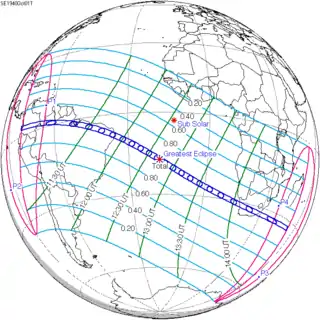 October 1, 1940 |
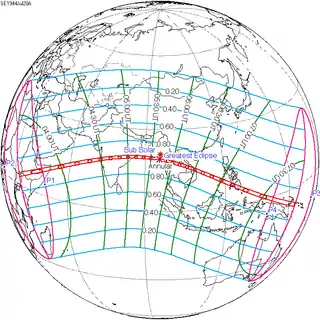 July 20, 1944 |
 May 9, 1948 |
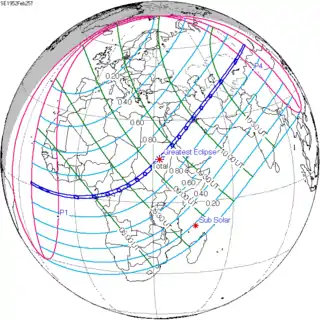 February 25, 1952 |
| 141 | 143 | 145 | 147 | 149 |
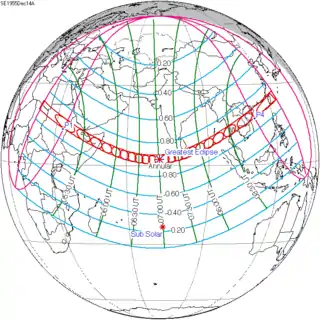 December 14, 1955 |
 October 2, 1959 |
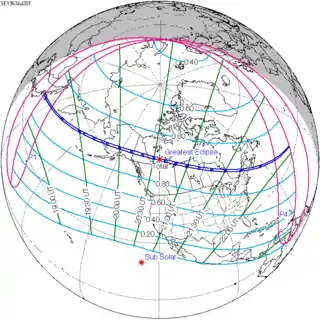 July 20, 1963 |
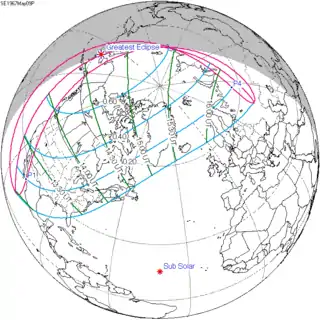 May 9, 1967 |
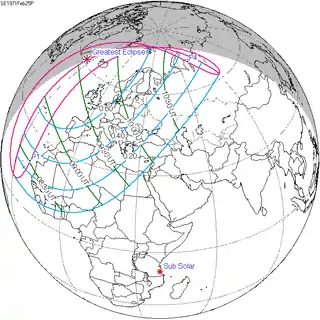 February 25, 1971 |
| 151 | 153 | 155 | ||
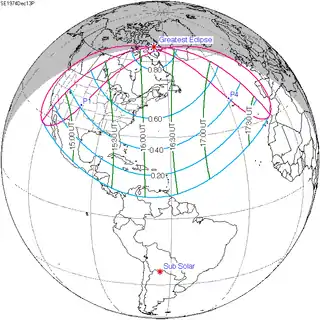 December 13, 1974 |
 October 2, 1978 |
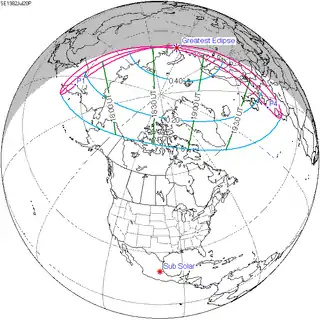 July 20, 1982 | ||
Tritos series
This eclipse is a part of a tritos cycle, repeating at alternating nodes every 135 synodic months (≈ 3986.63 days, or 11 years minus 1 month). Their appearance and longitude are irregular due to a lack of synchronization with the anomalistic month (period of perigee), but groupings of 3 tritos cycles (≈ 33 years minus 3 months) come close (≈ 434.044 anomalistic months), so eclipses are similar in these groupings.
| Series members between 1901 and 2100 | |||
|---|---|---|---|
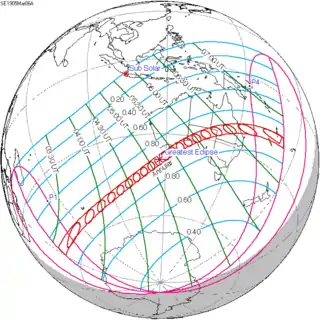 March 6, 1905 (Saros 138) |
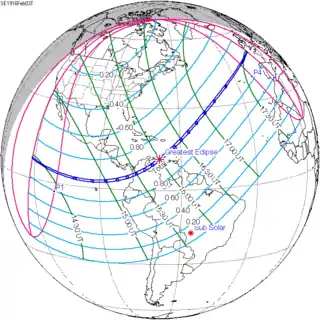 February 3, 1916 (Saros 139) |
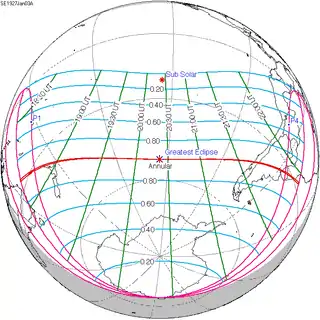 January 3, 1927 (Saros 140) | |
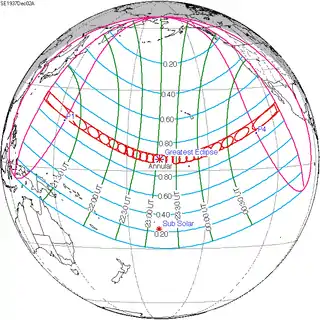 December 2, 1937 (Saros 141) |
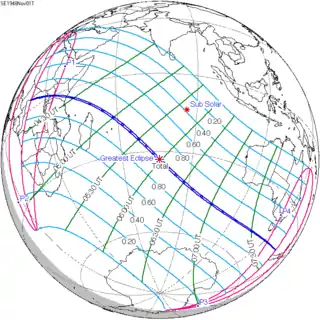 November 1, 1948 (Saros 142) |
 October 2, 1959 (Saros 143) | |
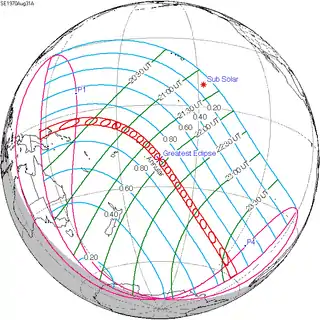 August 31, 1970 (Saros 144) |
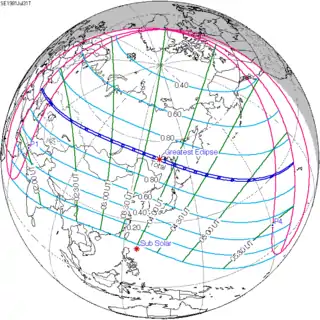 July 31, 1981 (Saros 145) |
 June 30, 1992 (Saros 146) | |
 May 31, 2003 (Saros 147) |
 April 29, 2014 (Saros 148) |
 March 29, 2025 (Saros 149) | |
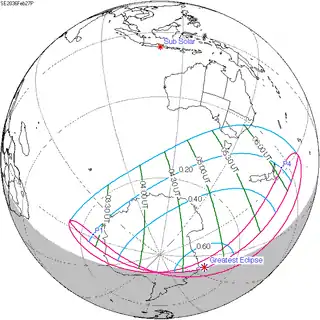 February 27, 2036 (Saros 150) |
 January 26, 2047 (Saros 151) |
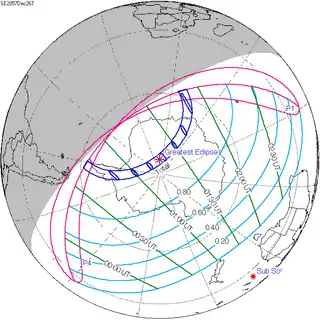 December 26, 2057 (Saros 152) | |
 November 24, 2068 (Saros 153) |
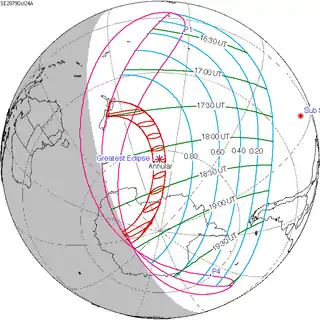 October 24, 2079 (Saros 154) |
 September 23, 2090 (Saros 155) |
|
See also
Notes
- ↑ Journal of the Royal Astronomical Society of Canada, Vol. 54, p.43,
- ↑ Sky and Telescope, Vol. XIX, No. 1, p. 4.
- ↑ The Shadowy Details of Today's Solar Eclipse | Space
- ↑ "Utrecht eclipse expeditions".
- ↑ Report of the Netherlands expedition for the observation of the total solar eclipse on october 2, 1959. Houtgast, J., Proceedings of the Royal Netherlands Academy of Arts and Sciences, Vol. 63, Nr. 5, p. 611 (1960)
- ↑ Allais, Maurice (1959). "Should the Laws of Gravitation be Reconsidered?". Aero/Space Engineering. 9: 46–55.
- ↑ van Gent, R.H. "Solar- and Lunar-Eclipse Predictions from Antiquity to the Present". A Catalogue of Eclipse Cycles. Utrecht University. Retrieved 6 October 2018.
References
- Earth visibility chart and eclipse statistics Eclipse Predictions by Fred Espenak, NASA/GSFC
.jpg.webp)

